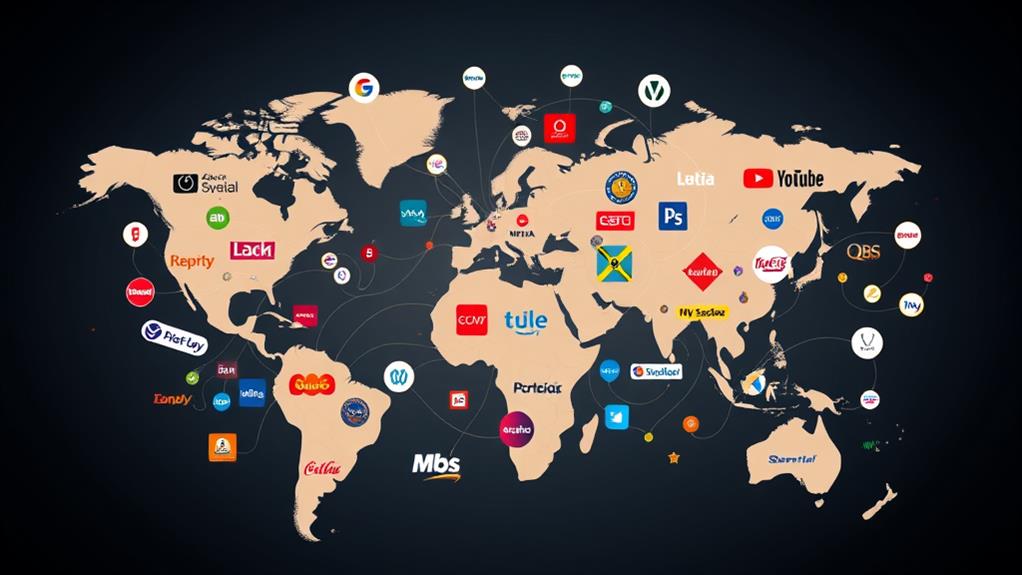The Role of Brand Positioning in Business Success
Brand positioning plays a pivotal role in business success by establishing a distinctive identity that resonates with consumers. It enables companies to communicate their unique value propositions effectively, fostering emotional connections and loyalty. By rigorously analyzing target audience needs, businesses can craft relevant messaging that addresses specific pain points, differentiating themselves from competitors. Consistent brand positioning cultivates awareness, enhancing visibility and recall in a crowded marketplace. Additionally, it serves as the foundation for impactful marketing strategies, driving sustained engagement and customer retention. Understanding these dynamics reveals the deeper implications of brand positioning and its transformative effects on long-term success.
Key Takeaways
- Brand positioning creates a unique identity that influences consumer perception and fosters emotional connections, essential for business success.
- A compelling unique value proposition (UVP) differentiates a brand from competitors, enhancing customer trust and loyalty.
- Understanding target audience demographics and pain points allows for tailored messaging and effective solutions, driving brand relevance.
- Effective communication strategies and consistent messaging across channels enhance brand visibility and awareness, crucial for sustained success.
- Continuous assessment of market trends and competitive landscape informs strategic adjustments, ensuring alignment with consumer needs and preferences.
Understanding Brand Positioning

Brand positioning serves as the cornerstone of a company's identity in a competitive marketplace, effectively differentiating it from its rivals. This strategic process involves crafting a unique space in the minds of consumers, thereby influencing brand perception and shaping consumer behavior.
A well-executed brand positioning strategy articulates what the brand stands for, its values, and its offerings, enabling it to resonate with target audiences on an emotional and rational level.
Understanding brand positioning is critical, as it directly impacts how consumers perceive a brand in relation to its competitors. A brand that successfully communicates its unique attributes cultivates a favorable image, fostering loyalty and encouraging repeat purchases.
This psychological anchoring influences consumer behavior, as individuals are more likely to gravitate toward brands that align with their values, aspirations, and identity.
Moreover, brand positioning must be continuously evaluated and refined in response to market dynamics and evolving consumer preferences. Companies that neglect this adaptive approach risk becoming irrelevant or misaligned with their target audience.
The interplay between brand perception and consumer behavior necessitates a deep understanding of market trends, competitive analysis, and customer insights.
Importance of Unique Value Propositions
A compelling unique value proposition (UVP) is essential in reinforcing a brand's positioning and differentiating it from competitors. A well-articulated UVP not only enhances value creation but also shapes customer perception, fostering an emotional connection that is crucial for long-term success.
By clearly communicating what sets a brand apart, businesses can effectively capture market appeal and strengthen their visual identity.
Consider the following key elements that underscore the importance of a robust UVP:
- Messaging Consistency: A strong UVP guarantees that all brand communications align with the core mission, creating a coherent narrative that resonates with consumers.
- Market Positioning: A well-defined UVP helps establish a distinct market positioning, allowing brands to occupy a unique space in the minds of consumers, thereby enhancing competitive advantage.
- Consumer Trust: When a UVP is authentic and transparent, it builds consumer trust, encouraging loyalty and repeat business. Trust is a critical factor in today's saturated market.
- Brand Storytelling: A compelling UVP serves as the foundation for effective brand storytelling, allowing companies to connect with their audience on a deeper level. This emotional connection can greatly influence purchasing decisions.
Analyzing Target Audience Needs

Understanding the needs of your target audience is essential for effective brand positioning.
By identifying key demographics, recognizing their specific pain points, and evaluating prevailing market trends, businesses can create tailored solutions that resonate deeply with consumers.
This approach not only enhances customer engagement but also drives sustained business success.
Identifying Key Demographics
Identifying key demographics is essential for businesses aiming to tailor their offerings and marketing strategies effectively. A thorough understanding of demographic segmentation allows organizations to hone in on specific customer profiles, thereby enhancing the relevance of their messaging and product development.
Audience profiling, which involves analyzing various demographic factors, equips businesses with insights that drive strategic decisions.
To achieve effective audience profiling, consider these four critical dimensions:
- Age: Understanding age distribution helps tailor marketing messages that resonate with different life stages.
- Gender: Gender-specific preferences can dictate product features, advertising channels, and promotional strategies.
- Income Level: Income brackets influence purchasing power, guiding the development of pricing strategies.
- Geographic Location: Regional preferences and cultural contexts can greatly inform product adaptation and marketing tactics.
Understanding Pain Points
Analyzing the pain points of a target audience is critical for businesses seeking to refine their products and services. Understanding these pain points—rooted in customer frustrations—enables companies to develop targeted solutions that resonate with their audiences.
By identifying the specific challenges and difficulties faced by potential customers, businesses can position their offerings as effective means of pain relief.
In-depth research, including surveys and interviews, can uncover the nuances of customer frustrations. This intelligence allows brands to tailor their messaging and product features to address the most pressing issues.
For instance, a technology company might discover that users are overwhelmed by complexity in their devices. By simplifying the user interface, the company not only alleviates this pain point but also enhances user satisfaction and loyalty.
Furthermore, addressing these pain points effectively can differentiate a brand in a crowded marketplace. When customers perceive that a brand genuinely understands and addresses their frustrations, it fosters trust and encourages long-term relationships.
Consequently, a thorough understanding of pain points is not merely an aspect of market research but a cornerstone of strategic brand positioning that drives business success.
Assessing Market Trends
Recognizing the interplay between customer pain points and market trends is essential for businesses aiming to align their offerings with evolving consumer needs.
To navigate this complex landscape, organizations must engage in thorough examination, focusing on critical factors that drive market dynamics.
- Trend Forecasting: This involves anticipating future consumer behavior shifts shaped by economic influences and technological advancements.
- Cultural Shifts: Understanding how societal changes affect consumer preferences is crucial for developing relevant products and marketing strategies.
- Industry Insights: Leveraging data from industry reports helps businesses gain a nuanced view of the competitive landscape, enabling informed decisions.
- Consumer Behavior Analysis: Regularly evaluating how target audiences react to products and services can provide actionable insights into their evolving needs.
Differentiation From Competitors
In today's competitive landscape, establishing a unique value proposition is essential for brands seeking to stand out.
Understanding the target audience's specific needs and preferences, combined with robust competitive analysis strategies, can greatly enhance a brand's ability to differentiate itself.
Unique Value Proposition
A compelling Unique Value Proposition (UVP) serves as the cornerstone of effective brand positioning, distinguishing a business from its competitors in a crowded marketplace.
A well-crafted UVP goes beyond mere features; it encapsulates value innovation and aligns closely with customer perception, guaranteeing that the brand resonates on a deeper emotional level.
To effectively convey a UVP, consider these essential elements:
- Clear Differentiation: Articulate what makes your brand unique, highlighting competitive advantages that set you apart.
- Emotional Connection: Leverage brand storytelling to foster an emotional connection with your audience, enhancing loyalty and trust.
- Market Alignment: Ascertain your UVP addresses the specific needs and desires of your target market, demonstrating relevance and urgency.
- Strategic Messaging: Maintain brand consistency across all channels, reinforcing your UVP through cohesive messaging that resonates with your audience.
Target Audience Identification
Identifying the target audience is a critical step in establishing a brand's position within the marketplace, as it enables businesses to tailor their offerings to meet specific consumer needs. A precise understanding of target demographics, coupled with psychographic segmentation, allows brands to explore beyond surface-level characteristics, capturing the motivations, values, and lifestyles that drive consumer behavior.
This depth of insight fosters a more resonant connection with potential customers, distinguishing a brand from its competitors. Incorporating behavioral analysis into this identification process further enhances a company's ability to adapt its strategies effectively.
By examining patterns in consumer purchasing behavior, brands can anticipate needs and preferences, refining their marketing messages to align with the identified target audience's expectations. This strategic alignment not only increases engagement but also builds brand loyalty over time.
Ultimately, the identification of a target audience is integral to effective brand positioning. It empowers businesses to create tailored experiences that resonate deeply, ensuring that messaging is not only relevant but also compelling.
Competitive Analysis Strategies
While many businesses may focus solely on their internal strengths and weaknesses, a thorough competitive analysis is essential for effective brand differentiation in the marketplace. Understanding how your brand stands relative to competitors can greatly enhance brand equity and market share.
To achieve successful differentiation, consider these competitive analysis strategies:
- SWOT Analysis: Evaluate your strengths, weaknesses, opportunities, and threats in the context of your competitors to identify unique positioning opportunities.
- Competitor Profiling: Examine the strategic positioning of your competitors, focusing on their market segmentation, brand perception, and value alignment.
- Pricing Strategies Assessment: Analyze competitor pricing strategies to determine how your pricing can be adjusted to enhance perceived value without sacrificing margins.
- Customer Segmentation Insights: Investigate how competitors segment their customer base and identify potential gaps that your brand could exploit for unique positioning.
Building Brand Awareness

Harnessing the power of effective communication, businesses can greatly enhance their brand awareness, which serves as a cornerstone for long-term success. In an increasingly competitive marketplace, brand visibility strategies become necessary. These strategies not only facilitate recognition but also foster an emotional connection with the target audience.
To achieve ideal brand visibility, organizations must leverage the capabilities of social media engagement. A multifaceted approach that includes consistent messaging, compelling content, and interactive platforms can remarkably amplify a brand's presence. By utilizing analytics to understand audience preferences, businesses can tailor their communication to resonate effectively. This targeted engagement not only captures attention but also encourages sharing, thereby widening the reach exponentially.
Moreover, it is essential to maintain a cohesive brand identity across all channels. Consistency in visual elements, tone, and messaging reinforces brand recall and fosters trust. Brands that successfully implement these visibility strategies often find themselves at a competitive advantage, as they are top-of-mind for consumers when making purchasing decisions.
In addition, collaborative partnerships with influencers or complementary brands can enhance visibility and introduce the brand to new audiences. Such strategic alliances can create a ripple effect, driving organic growth in brand recognition.
Ultimately, building brand awareness through well-executed visibility strategies and robust social media engagement is not merely an option; it is an indispensable endeavor for businesses aspiring to thrive in today's dynamic landscape. As brand awareness grows, so too does the foundation for sustained business success.
Impact on Customer Loyalty
Customer loyalty is profoundly influenced by a brand's positioning and the effectiveness of its communication strategies. A well-defined brand position fosters an emotional connection with consumers, which is essential for cultivating loyalty.
By aligning the brand's values and promises with customer expectations, businesses can enhance their customer retention strategies markedly.
Here are four key ways brand positioning impacts customer loyalty:
- Clarity of Purpose: A clearly articulated brand position helps consumers understand what the brand stands for, making it easier for them to relate to and trust the brand.
- Differentiation: Effective positioning distinguishes a brand from its competitors, allowing consumers to see unique value propositions that resonate with their needs and preferences.
- Consistent Messaging: Consistency in communication reinforces the brand's identity, leading to a deeper emotional connection. Customers are more likely to remain loyal when they perceive a brand as reliable and cohesive.
- Customer Experience: A strong brand position influences every customer interaction, ensuring that experiences align with brand promises. This alignment fosters satisfaction and loyalty, encouraging repeat business.
Role in Marketing Strategy

In the domain of marketing strategy, brand positioning serves as the cornerstone for effective communication and engagement with target audiences. A well-defined brand position not only clarifies the unique value proposition but also aligns with the nuances of target market segmentation. By identifying and understanding the specific demographics, psychographics, and behavioral traits of the audience, businesses can tailor their messaging and offerings to resonate more deeply, fostering a connection that drives engagement and loyalty.
Moreover, brand perception mapping plays a critical role in this strategic framework. This process involves analyzing consumers' perceptions of the brand relative to competitors, illuminating areas of strength and opportunity. By employing tools such as perceptual mapping, marketers can visualize how their brand is positioned in the minds of consumers, thereby making informed decisions about adjustments needed to enhance brand equity.
Effective brand positioning not only informs marketing tactics but also influences product development, pricing strategies, and promotional activities. It guarantees that every touchpoint reflects the desired brand image, thereby facilitating a cohesive and compelling narrative that speaks to the target market's needs and aspirations.
Ultimately, a robust brand positioning strategy enables organizations to carve out a distinct space in the marketplace, guaranteeing that they not only attract but also retain their ideal customers. Consequently, it becomes imperative for businesses to invest time and resources into refining their brand positioning, as it is integral to achieving sustainable business success in an increasingly competitive landscape.
Measuring Brand Positioning Success
Evaluating brand positioning success necessitates a systematic approach that integrates quantitative and qualitative metrics. By utilizing a combination of analytical tools, businesses can attain a holistic view of their brand's standing in the marketplace. Key performance indicators (KPIs) serve as essential benchmarks for evaluating the effectiveness of brand positioning strategies.
- Brand Perception Metrics: These metrics help gauge how consumers view the brand in relation to competitors, offering insights into brand equity measurement and informing necessary adjustments.
- Customer Feedback Analysis: Through surveys and reviews, organizations can collect invaluable insights that drive brand loyalty indicators, revealing customer sentiments and preferences.
- Market Share Evaluation: Analyzing changes in market share provides a quantitative measure of brand positioning success, exhibiting the impact of strategic initiatives on consumer acquisition.
- Sentiment Analysis Tools: These tools analyze social media and online discussions, helping brands understand consumer attitudes, emotions, and brand recall effectiveness.
Additionally, consumer behavior tracking can disclose trends and patterns, offering a deeper understanding of target demographics.
Adapting to Market Changes

Maneuvering the dynamic landscape of modern business requires brands to remain agile and responsive to market changes. Brand agility is not merely an asset; it is a necessity for sustaining competitive advantage. In an environment where consumer behavior is continually shifting, businesses must prioritize market responsiveness to identify and adapt to emerging trends swiftly.
Incorporating customer feedback into brand strategies fosters a deeper understanding of consumer needs and expectations. This insight enables companies to execute strategic pivots that align with evolving market demands, ensuring relevance in a crowded marketplace. Additionally, trend adaptation is essential for brands to not only survive but thrive amidst disruptive forces.
Innovation strategies play a central role in this evolution. By fostering a culture of creativity and experimentation, brands can develop flexible positioning that accommodates changing consumer preferences and technological advancements. This proactive approach to brand evolution allows businesses to stay ahead of competitors who may be slower to adapt.
Furthermore, a keen awareness of the competitive landscape is imperative. Companies must analyze their rivals' movements and adjust their strategies accordingly, ensuring they remain a step ahead.
The ability to pivot strategically, informed by real-time data and analytics, is essential for brands aiming to solidify their market position.
Frequently Asked Questions
How Does Brand Positioning Affect Employee Engagement and Morale?
Brand positioning greatly influences employee engagement and morale by fostering a strong alignment between individual values and brand identity.
When employees resonate with the brand's mission and vision, their commitment and enthusiasm increase, leading to enhanced productivity.
A well-defined brand identity not only clarifies organizational goals but also cultivates a sense of belonging, ultimately driving higher levels of morale.
Consequently, this alignment is essential for achieving organizational success and sustaining a motivated workforce.
Can Brand Positioning Change Over Time, and How?
Just as a river adapts to its surroundings, brand positioning can indeed evolve over time. Influenced by market dynamics, shifts in consumer perception, and the competitive landscape, brands must undertake strategic adjustments to remain relevant.
As industry trends emerge, organizations may need to recalibrate their messaging and offerings to resonate with target audiences. This brand evolution is essential for sustaining market relevance and ensuring long-term success in an ever-changing business environment.
What Are Common Mistakes in Brand Positioning?
Common mistakes in brand positioning include failing to conduct thorough market research and competitive analysis, which can result in a misalignment with the target audience.
Additionally, unclear messaging can confuse potential customers, undermining the value proposition.
Neglecting visual identity can weaken brand recognition, while an insufficient differentiation strategy may lead to a diluted customer perception.
Addressing these pitfalls is essential for establishing a strong brand presence that resonates effectively in a competitive landscape.
How Do Cultural Differences Impact Brand Positioning Strategies?
Cultural differences greatly influence brand positioning strategies, necessitating a deep understanding of cultural nuances within global markets.
Brands must adapt their messaging and offerings to resonate with diverse consumer values, preferences, and behaviors.
Failure to acknowledge these differences can lead to misinterpretation and diminished brand equity.
As a result, successful positioning requires a tailored approach that aligns with local cultural contexts, ensuring relevance and fostering stronger connections with target audiences across various regions.
What Role Does Storytelling Play in Brand Positioning?
Ah, storytelling—because who doesn't want a brand that feels like a Netflix series?
In brand positioning, narrative techniques are essential; they weave a compelling tale that fosters an emotional connection with consumers. This connection transforms mere products into memorable experiences, effectively differentiating a brand in a saturated market.
Mastering storytelling not only enriches brand identity but also engages audiences, ensuring that the brand resonates long after the last chapter is closed.
Conclusion
Ultimately, effective brand positioning serves as a cornerstone for business success, shaping perceptions and fostering loyalty among consumers. With a clear understanding of unique value propositions and target audience needs, organizations can differentiate themselves in competitive landscapes. The ability to adapt to market changes further enhances this positioning. Ultimately, how can companies leverage brand positioning to not only attract customers but also sustain long-term growth in an ever-evolving marketplace?




